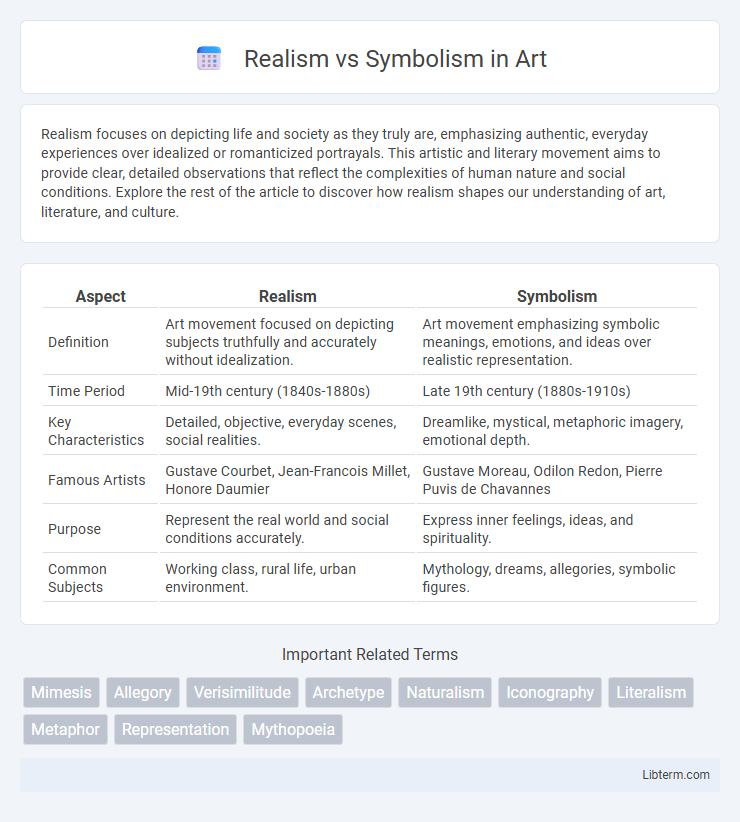Realism focuses on depicting life and society as they truly are, emphasizing authentic, everyday experiences over idealized or romanticized portrayals. This artistic and literary movement aims to provide clear, detailed observations that reflect the complexities of human nature and social conditions. Explore the rest of the article to discover how realism shapes our understanding of art, literature, and culture.
Table of Comparison
| Aspect | Realism | Symbolism |
|---|---|---|
| Definition | Art movement focused on depicting subjects truthfully and accurately without idealization. | Art movement emphasizing symbolic meanings, emotions, and ideas over realistic representation. |
| Time Period | Mid-19th century (1840s-1880s) | Late 19th century (1880s-1910s) |
| Key Characteristics | Detailed, objective, everyday scenes, social realities. | Dreamlike, mystical, metaphoric imagery, emotional depth. |
| Famous Artists | Gustave Courbet, Jean-Francois Millet, Honore Daumier | Gustave Moreau, Odilon Redon, Pierre Puvis de Chavannes |
| Purpose | Represent the real world and social conditions accurately. | Express inner feelings, ideas, and spirituality. |
| Common Subjects | Working class, rural life, urban environment. | Mythology, dreams, allegories, symbolic figures. |
Introduction to Realism and Symbolism
Realism emphasizes accurate, detailed representation of everyday life and ordinary people, aiming to depict subjects truthfully without artificiality or artistic conventions. Symbolism, emerging as a reaction to Realism, prioritizes the expression of ideas, emotions, and dreams through metaphorical and symbolic imagery rather than direct observation. These distinct movements influenced 19th-century literature and art, marking a shift from external reality to internal experience.
Historical Backgrounds of Both Movements
Realism emerged in the mid-19th century as a reaction against Romanticism, emphasizing accurate, detailed depictions of everyday life and social conditions, particularly influenced by the industrial revolution and political upheavals in France. Symbolism arose in the late 19th century as a response to Realism's focus on external reality, drawing from Romanticism and inspired by mysticism, mythology, and dreams to explore inner experiences and emotions. Both movements reflect distinct historical contexts: Realism aligned with democratic ideals and scientific progress, while Symbolism corresponded with fin-de-siecle anxieties and a search for deeper spiritual meaning.
Key Philosophical Differences
Realism emphasizes the objective representation of everyday life, focusing on observable phenomena and concrete details to depict the external world as it is. Symbolism prioritizes subjective interpretation, using metaphor, allegory, and symbolic imagery to express inner emotions, spiritual truths, and abstract ideas beyond visible reality. Where Realism roots itself in empirical evidence and social conditions, Symbolism explores subconscious experience and mystical meaning.
Major Themes in Realist Art and Literature
Realism in art and literature emphasizes accurate, detailed depictions of everyday life, focusing on social issues, class struggles, and the ordinary experiences of common people. It prioritizes objective observation and rejects romanticized or idealized portrayals, aiming to reveal the true conditions of society. Major themes include social injustice, poverty, ethical dilemmas, and the conflict between individual desires and societal expectations.
Symbolism: Meaning Beyond the Surface
Symbolism in art and literature conveys deeper meanings beyond literal appearances by using symbols to represent ideas, emotions, and spirituality. This movement often explores themes of dreams, myth, and the mystical, highlighting the intangible aspects of human experience. Symbolist works challenge viewers to interpret hidden messages, emphasizing subjective and emotional reality rather than objective representation.
Influential Realist and Symbolist Figures
Gustave Courbet and Edouard Manet stand as influential figures of Realism, emphasizing accurate depictions of everyday life and social realities. Symbolism, led by Gustave Moreau and Odilon Redon, centers on conveying mystical and emotional experiences through symbolic imagery and dreamlike compositions. These artists profoundly shaped their respective movements, challenging traditional artistic conventions and inspiring future explorations in visual expression.
Techniques and Styles: A Comparative Analysis
Realism employs detailed, accurate depictions of everyday life, using natural light and true-to-life color palettes to emphasize authenticity and social reality. Symbolism prioritizes evocative imagery and metaphorical elements, often utilizing dreamlike compositions, muted tones, and exaggerated forms to convey emotional or spiritual meanings. Realism's technique centers on objective observation, while Symbolism embraces subjectivity and abstraction to explore deeper psychological or mystical themes.
Impact on Modern Art and Literature
Realism's detailed representation of everyday life challenged traditional artistic norms and laid the groundwork for modern art's embrace of authenticity and social critique. Symbolism's emphasis on emotion, mysticism, and the subconscious influenced modern literature and art by inspiring abstract, psychological, and dreamlike themes. Both movements catalyzed a shift away from classical forms, fostering innovation in narrative techniques and visual expression in 20th-century modernism.
Realism vs Symbolism in Contemporary Culture
Realism in contemporary culture emphasizes authentic representation and detailed depiction of everyday life, fostering a connection with actual experiences and social conditions. Symbolism counters this by using metaphorical imagery and abstract concepts to evoke emotions and explore deeper meanings beyond surface realities. The tension between realism and symbolism shapes modern art, literature, and media by balancing factual accuracy with imaginative interpretation.
Conclusion: The Ongoing Dialogue
Realism and Symbolism continue to shape modern art by offering contrasting approaches--Realism emphasizes accurate depiction of everyday life, while Symbolism explores deeper emotional and mystical meanings. This ongoing dialogue drives artistic innovation, encouraging creators to balance tangible representation with abstract interpretation. The dynamic interplay between these movements enriches cultural expression and invites continuous re-examination of artistic purpose.
Realism Infographic

 libterm.com
libterm.com